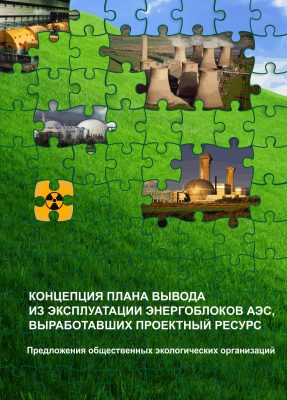5. Radioactive waste produced at NPP decommissioning
RW volume will considerably grow during the NPP decommissioning, which will bring dramatic changes in the total RW situation.
That is why the establishment of unified efficient system of RW management is a key task within the decommissioning program.
Solid radioactive waste (SRW) during NPP decommissioning
SRW produced at NPP decommissioning can be grouped into three large categories of different activity levels and having a number of specific properties:
- metallic waste;
- construction waste;
- waste arising at dismantling, resulting from the destruction of protective barriers.
SRW of decommissioned VVER-440
The radioactivity of decommissioned VVER-440 structures is ~ 2,5 mln. Ci, including the radioactivity of in-vessel instrumentation - 1,2 mln. Ci. The mass of reactor structures and in-vessel instrumentation is ~ 300 t. Metallic waste formed by dismantled pipelines, fittings, etc, belongs to the medium- and low-level waste group. Its activity results mostly from corrosion products, and it ranges from 1×10-8 to 1×10-4 Ci/kg.
All in all, during the decommissioning of VVER-440 power unit ~ 14 th. t of metallic RW and ~ 10 th. t of contaminated concrete and building structures is produced. In addition to that RW listed in the table, reactor structures and in-vessel instrumentation metallic waste includes:
- equipment of RW processing units;
- RW kept in the plant site storages;
- Structures of RW storages and other auxiliary equipment.
SRW at RBMK-1000 decommissioning
The situation with SRW produced at the decommissioning of RBMK-1000 power unit is more complex, because the amount of waste arising during its dismantling is still larger. It is about 100 th. t of concrete and 10 th. t of steel with a total radioactivity of 2.8 mln. Ci (105 TBq). Beside metallic SRW and demolished structures, it is also necessary to manage 1700 t of radioactive graphite, the reprocessing technology of which is still unavailable.
LRW at NPP decommissioning
LRW produced at decommissioning Russian NPPs include:
- equipment and rooms decontamination and washing liquids - 25 th. m3;
- water from emptied reactor systems - 1000 m3;
- water from the sanitary checkpoints, bathrooms, laundry rooms - 30 th. m3;
- pulps of pearlite, ion-exchange resins, bottom sludge - 200 m3;
- vat residues, condensate from the LRW evaporation units - 20 th. m3.
This waste belongs to the low-level category. The specific activity of the most is from 1×10-6 to 1×10-4 Ci/l, and the total volume of the whole inventory of such waste is up to 100 th. m3
Дополнительные материалы
This topic focuses on the existing experience of long-term isolation of radioactive wastes from the environment in Russia
Lectures on this topic:
- 01. Operational RW and SNF of Russian VVER and RBMK reactors
- 02. Generation of solid radioactive waste (SRW)
- 03. Recycling of metallic radioactive waste
- 04. Spent nuclear fuel (SNF)
- 05. Radioactive waste produced at NPP decommissioning
- 06. Necessity of establishing a unified RW management system
- 07. Proposals for establishing regional RW repository in the North-West Russia
- 08. Legal provisions for RW management in Russia
- 09. Importance of using the international experience of RW and SNF management
- 10. European experience
TOPIC OF COURSE
- Topic 01. Current condition of nuclear energy
- Topic 02. Legislation in the US and in Russia
- Topic 03. International law in the sphere of decommissioning
- Topic 04. Role of the national regulators in the decommissioning process
- Topic 05. Possible approaches and scenarios of decommissioning
- Topic 06. Existing experience of decommissioning
- Topic 07. Strategy for handling radioactive waste (RW) and spent nuclear fuel (SNF) USA experience
- Topic 08. Strategy for handling RW and SNF Russian experience & other countries
- Topic 09. Social aspects of decommissioning
- Topic 10. International and inter-regional cooperation for safe decommissioning
